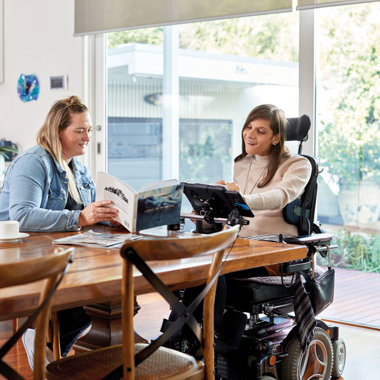Outcome area Inclusive homes and communities
Desired outcome: People with disability can participate in their communities and live in homes that meet their needs.
Data can currently be reported for 9 measures. For the remaining measures, work will occur over the life of the Strategy to enable reporting.

Key findings
-
The time waited by households with a disability for public housing was over 600 days on average in 2022–23
-
Just under 1 in 5 lower income households with at least one person with disability were in housing stress in 2019–20
-
In 2018, more than 9 in 10 people with disability had participated in community or social activities in the past 12 months
Priorities
-
Improving access to affordable housing for people with disability
-
Average time waited for social housing
Regress - the measure is not moving in the direction the Strategy wants
637 days was the average time waited for public housing by newly allocated households with disability in 2022–23
406 days was the average time waited for state owned and managed Indigenous housing (SOMIH) by newly allocated households with disability in 2022–23
-
Lower income housing stress
Status not known yet - more data from after the Strategy started are needed
18% of lower income households with at least one person with disability were in housing stress in 2019–20
-
-
Making sure people with disability can live in homes that meet their needs
-
NDIS participants housing satisfaction
Regress - the measure is not moving in the direction the Strategy wants
72.8% of NDIS participants were happy with their current home in 2023–24 Q2
-
Social housing accessibility
No data currently available Data for this measure will be added when it becomes available
-
-
Supporting the inclusion of people with disability in their communities
-
NDIS participants pursuing interests
Regress - the measure is not moving in the direction the Strategy wants
64% of NDIS participants spent free time doing activities that interest them in 2023–24 Q2
-
Social participation
Status not known yet - more data from after the Strategy started are needed
95% of people with disability participated in a cultural, sport or social activity in the past 12 months in 2018
-
-
Making sure the buildings and facilities people with disability visit are accessible
-
Access to government buildings
Status not known yet - more data from after the Strategy started are needed
8.1% of people with disability had difficulty accessing government buildings in 2018
-
Accessing buildings and facilities
Status not known yet - more data from after the Strategy started are needed
69% of people with disability reported in 2018 they had no difficulty accessing buildings or facilities in the last 12 months
-
-
Making sure people with disability can access the public transport they need
-
Public transport usability
Status not known yet - more data from after the Strategy started are needed
66% of people with disability said they can use all forms of public transport with no difficulty in 2018
-
Public transport compliance
Future data development Data for this measure will be added when it becomes available
-
-
Supporting people with disability to be able to find and use information they need
-
Digital inclusion gap
Regress - the measure is not moving in the direction the Strategy wants
11.7 points was the digital inclusion gap between people with disability and the Australian population in 2022 (score scale 0–100)
-
Government website accessibility
Future data development Data for this measure will be added when it becomes available
-
Status key
Back to top- Progress Used where there are 2 or more data points, including at least one data point after the start of the Strategy (December 2021), and the measure is moving in the direction the Strategy wants to see.
- No change Used where there are 2 or more data points, including at least one data point after the start of the Strategy (December 2021), and the latest data are similar to the baseline.
- Regress Used where there are 2 or more data points, including at least one data point after the start of the Strategy (December 2021), and the measure is not moving in the direction the Strategy wants to see.
- Status not known yet Used when there is not enough data available yet to report on progress. This occurs when there is only one data point available (usually the baseline) or data after the start of the Strategy (December 2021) is yet to become available.
- Confidence status Added to indicate that care should be taken when looking at a reported status as there is some uncertainty in the data.



